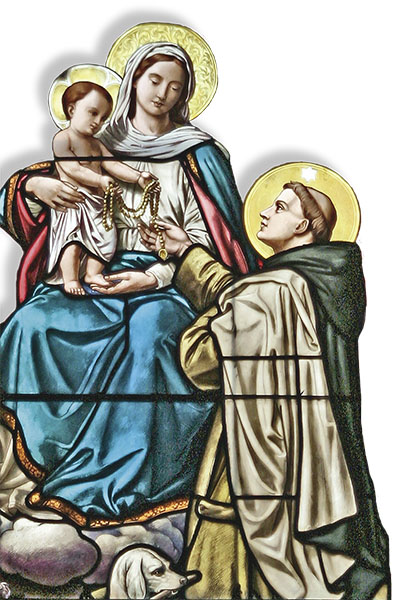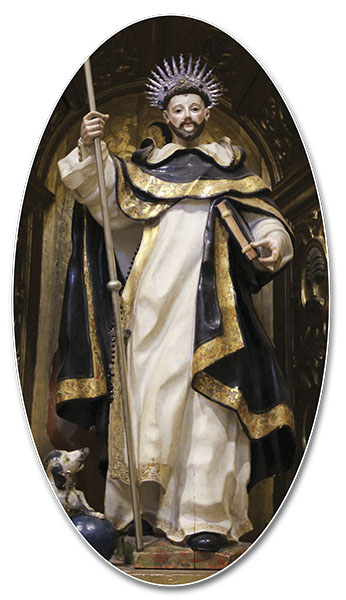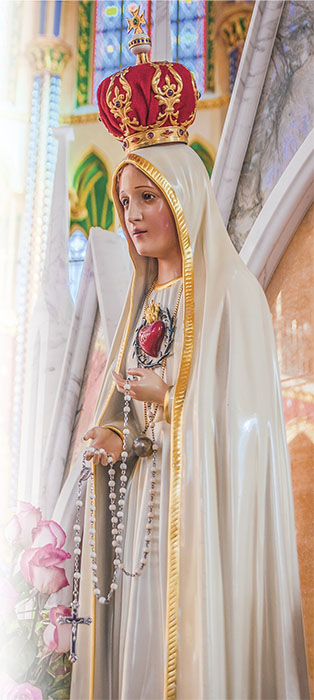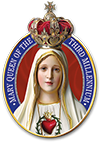
For many, the Rosary may appear to be a subject about which nothing further remains to be said.
It is a magnificent prayer, without a doubt. But could there be a single nook in this splendid palace which has not yet been thoroughly explored, mapped out and catalogued by the cohort of Saints and theologians who have so far ventured to enter it? What could possibly motivate someone to write a few pages on this subject, if they are destined to be lost among the thousands – perhaps millions – that have already been written?
Although there is some validity in these questions, they do not express the full reality. Our Lord compares the scribe who becomes a disciple of the Kingdom of God to a father who brings out of his treasure things new and old (cf. Mt 13:52). In an analogous way, everything that Holy Church has engendered throughout the centuries always has an application for the present time, and it is the task of Catholics to point it out.
In this sense, it is not difficult to demonstrate that the Rosary is extremely timely. However, in order to appreciate the “new things” in this treasure, it will first be necessary to contemplate the quality of some of the jewels of venerable antiquity which compose it.
The excellence of the Holy Rosary according to the Popes
Do we really know the enormous power of this prayer, apparently so simple, so unassuming, so accessible and so widely spread by popular devotion?
Recourse to the papal Magisterium will certainly provide us with a firm foundation on which to base our answer.
The Popes have called it “the perfect prayer,”1 “the summary of Gospel teaching,”2 the “badge of Christian piety,”3 “the sweet chain linking us to God, the bond of love uniting us to the Angels, the tower of salvation against the assaults of hell,”4 “the sure guarantee of divine power, the support and defence of our hoped-for salvation.”5
The Rosary has the “power to instil confidence into the hearts of those who pray,”6 to rekindle the Catholic Faith, revive hope and inflame charity; it preserves chastity and integrity of life.7 In short, it is “the great bulwark against heresy and vice”8 and “the way to attain every virtue.”9
Theologians give it first place
Yet if the superlative praise of the Popes is not enough to convince us that the Rosary is “the most beautiful prayer, the richest in grace and the most pleasing to the Heart of Mary,”10 we may still have recourse to the Doctors. There is a theological reason of great beauty which justifies the lofty position occupied by this prayer in relation to the others.
Broadly speaking, the types of prayer can be divided into two main groups: vocal and mental. Using an analogy with the human being, we could say that the first is to the second more or less as the body is to the soul. In vocal prayer, the words used to address God – whether they are found in a missal or breviary, in the case of an official prayer, or even from a book, a devotional card or any other source – constitute the “material” element of the prayer, which serves to stimulate mental prayer. The latter, in its turn, is properly the raising of the mind to God, that is to say, it takes place when we use our intelligence and heart to contemplate and love heavenly realities, with the help of grace.
Now, among vocal prayers, what could surpass the Our Father, composed by the God-Man himself (cf. Mt 6:9-13), the Angelic Salutation (cf. Lk 1:28,42) and the Glory be to the Father, in honour of the Blessed Trinity? And in the field of mental prayer, what more sublime theme for meditation can be found than the mysteries of the life, Passion, Death and Resurrection of Our Lord Jesus Christ, contemplated throughout the Rosary?
Therefore, the renowned theologian Fr. Antonio Royo Marín, OP, sums up this prayer as “encompassing the advantages of mental and vocal prayer to the most perfect degree objectively possible.”11
A great historical mystery

Another factor, perhaps even more sublime than the preceding ones, also points to the grandeur of the Rosary: its origin. Those who believe that it is a devotion descended from Heaven and given to mankind personally by the Blessed Virgin are not wrong. Yet there is controversy as to whether or not it was first revealed to St. Dominic.
History, always bound to documents that have survived the passage of time, says merely that a great mystery hovers over the origins of the Rosary. There are no records from the thirteenth century attesting that St. Dominic was the initiator of this devotion, since it did not appear in the writings of popes and authors until the fifteenth century. They were preceded only by Catholic piety, which, it is true, always precedes in some manner the official proclamation of the most beautiful truths of Mariology.
In fact, long before the birth of that holy preacher, a pious custom was already in place among Christians of reciting the Hail Mary one hundred and fifty times in place of the Psalms of David, which were recited in the early days of the Church. This led to the prayer becoming known as the Psalter of Mary.12
Only in the XIII century – at the time when St. Dominic developed his apostolate – did this practice spread all over Christendom, and its main promoters were the Dominicans! Mere coincidence? Again, a mystery…
The only source capable of providing us with any information on the subject – less appealing to unbelieving spirits – is the voice of mysticism, which, especially in the person of Blessed Alan de la Roche, presents an account imbued with the sense of the marvellous. Is it entirely veridical? A certain enigma remains, and perhaps will remain until the end of time… But what is certain is that the account of this Dominican religious is so in keeping with St. Dominic’s prophetic vocation that, if it presents any inconsistency with reality, we are inclined to believe that events unfolded in an even more sublime manner.13
Narration of Blessed Alan de la Roche

St. Dominic of Guzman is labouring with great effort to convert the Albigensian heretics, who have been devastating Europe since the 12th century, especially in the Languedoc region in of southern France. His dedication, however, is not bearing much fruit, as the number of those who adhere to the Cathar sect only grows daily.
Distraught, the faithful devotee of Mary retires to a forest near Toulouse to beseech Heaven to put an end to this calamity. After three days of fasting and sacrifices, his strength fails him and he collapses.
But just when his physical forces have been pushed to their extreme limit, the Blessed Virgin approaches, enveloped in intense light, and asks him:
“My dear Dominic, do you know with what weapon the Blessed Trinity wants to reform the world?”
“You know better than I do,” replies an astounded Dominic.
“Know, then, that the principal arm of combat is the Angelic Salutation, cornerstone of the New Testament. If you want to win these hardened hearts for God, pray my Psalter.”
After these words, a furious storm suddenly breaks out, with lightning, thunder, torrential rain and earthquakes. Terrified, the population of the city takes refuge in the cathedral, to the sound of the bells that miraculously peal of their own accord.
The tempest continues to rage for some time, and only ceases with the prayers of St. Dominic, who is already in the cathedral, before the assembly. Consoled by the help of the Queen of Angels, he then proclaims the Holy Rosary to them. Almost all the inhabitants of Toulouse accept it, and abandon their evil ways.14
Thus, amidst stupendous miracles, this devotion was said to have arisen, a gift from Heaven brought by Our Lady herself for the benefit of men.
The Rosary at times of crisis
 We promised, at the outset, to deal with the timeliness of the Rosary.
We promised, at the outset, to deal with the timeliness of the Rosary.
This year, we will observe the concurrence of three great commemorations, all of them connected with this devotion. In the first place, it is the 850th anniversary of St. Dominic’ birth, and the 800th anniversary of his death.15 In addition, the current month marks the 450th anniversary of the Battle of Lepanto, a key event in the history of Christendom, which led to the institution of the feast of Our Lady of the Rosary.16
Why is this important for the present moment?
The most crucial moments in the history of the Rosary were precisely those when calamity had reached a peak. During the time of St. Dominic, the Faith was being threatened by the Albigensian heresy, and the Saint employed the Rosary to safeguard orthodoxy. At Lepanto, the visible structure of the Church and Christian Civilization was on the verge of collapse. The Rosary of St. Pius V wrought for Don Juan of Austria the same victory that the arms of Moses, stretched out on the mountain top, won for Joshua against the Amalekites (cf. Ex 17:8-13).
In both cases, the pledge of victory was this same celebrated devotion.
Powerful weapon for our days
Today the Faith and the Holy Church would seem to be equally or even more endangered than in those times. Their worst enemies no longer use clear arguments in open debates, nor do they fight with weapons of iron or fire. Rather, they take advantage of darkness to grow, ambiguity to conquer and relativism to demolish.
We must therefore make use of every means within our reach to confront this crisis, and the Rosary, as we have seen, can obtain God’s intervention in these events.
Just as St. Dominic and St. Pius V made use of it as a “weapon to defeat the enemies of God and of religion,”17 so the faithful of today, armed with this same instrument of warfare, will easily succeed in destroying the monstrous errors and impieties which are arising everywhere.18
This is why Mary Most Holy, on two occasions, at Lourdes and Fatima, instructed all of humanity to pray it. In the Cova da Iria – indeed, during the apparition of October – the Virgin affirmed: “I am the Lady of the Rosary.” Under this standard Christians have triumphed in the past; and under it they will triumph today and always.
1 Benedict XV. Letter “Di altissimo pregio”, 18/9/1915.
2 Leo XIII. Amantissimæ voluntatis.
3 Leo XIII. Supremi apostolatus.
4 PiUS XI. Apostolic Brief, 20/7/1925.
5 PiUS XII. Letter “Philippinas insulas”, 31/7/1946.
6 Leo XIII. Iucunda semper, n.3.
7 Cf. Pius XI. Ingravescentibus malis.
8 BenEDICT XV. Letter “In cœtu sodalium”, 29/10/1916.
9 PiUS XI. Apostolic Brief, 20/7/1925.
10 PiUS IX. Letter “Pium sane”, 24/3/1877.
11 ROYO MARÍN, OP, Antonio. La Virgen María. Teología y espiritualidad marianas. 2.ed. Madrid: BAC, 1997, p.467.
12 Cf. ST. LOUIS-MARIE GRIGNION DE MONTFORT. Le secret admirable du très Saint Rosaire. Montreal: Librarie Montfortaine, 1947, p.14-15.
13 Cf. GETINO, Luis G. Alonso. Santo Domingo de Guzmán. Madrid: Biblioteca Nueva, 1939, p.172-185.
14 Cf. ST. LOUIS-MARIE GRIGNION DE MONTFORT, op. cit., p.2-4. This booklet by the great Marian doctor was praised by St. John Paul II as “an excellent work on the Rosary” (Rosarium Virginis Mariæ, n.8). It should also be noted that Blessed Alan and St. Louis de Montfort were the principal apostles of the Rosary in France, as the Dominican theologian Réginald Garrigou-Lagrange points out (cf. La Madre del Salvador y nuestra vida interior. 3.ed. Buenos Aires: Desclée de Brouwer, 1954, p.266).
15 As is typical with ancient figures, there is disagreement among authors about the year of St. Dominic’s birth. The fact that he was born at the end of 1171 has been taken from the collection ECHEVERRÍA, Lamberto de; LLORCA, SJ, Bernardino; REPETTO BETES, José Luis (Org.). Año Cristiano. Madrid: BAC, 2005, v.VIII, p.197.
16 The celebration of Our Lady of the Rosary was instituted by St. Pius V in thanksgiving for the triumph of the Christian fleet at the Gulf of Lepanto on October 7, 1571, while the confraternities of Rome celebrated Rosary processions, one of them presided over by the Supreme Pontiff himself. Originally, however, the Blessed Virgin was invoked as Our Lady of Victories, which was gradually replaced by Our Lady of the Rosary. In 1716, Clement XI extended the commemoration to the Universal Church. Leo XIII introduced it into the Liturgy, and St. Pius X fixed October 7 as the definitive date (cf. ROYO MARÍN, op. cit., p.507).
17 PiUS XI. Ingravescentibus malis.
18 Cf. PiUS IX. Egregiis, 3/12/1856.
